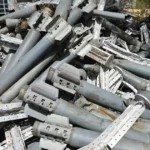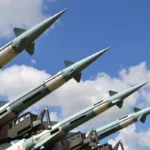US needs to double down on directed energy weapons
In the 1980s, the United States faced a profound challenge: winning a conventional war in Europe against a numerically superior Soviet army.
Technological innovation – most notably the development of smart, precision munitions – provided a solution. Instead of needing tens or even hundreds of unguided munitions to hit a target, one smart munition would often suffice.
This meant that a single plane could destroy a whole series of Russian tanks in a single mission, or strike a series of logistics and infrastructure targets, with the expectation of hitting nearly every one.
This produced a revolutionary asymmetry and made huge Soviet investments obsolete. Precision provided a way to defeat scale.
Today, the US faces a similar situation: its adversaries are mass-producing drones and missiles at enormous scale. A revolutionary new technology is desperately needed in order to make this investment obsolete.
Today, China controls 70% of the world’s production of enterprise drones and 90% of the commercial drone market. They supply technology and components to Russia for its war on Ukraine. Russia uses hundreds of drones and missiles every day to attack civilian and infrastructure targets in Ukraine.
Hezbollah, an Iranian proxy, has an estimated stockpile of 150,000-200,000 rockets and missiles, more than enough to overwhelm Israel’s Iron Dome defenses. The defensive munitions for Iron Dome cost around US$40,000 per missile while the offensive munitions can, in many cases, cost much less.
SM-3 and SM-6 missiles, used to intercept ballistic missiles, cost between millions and tens of millions of dollars each. Drone and missile-based air war is currently offensive-dominant.
To stop China from invading Taiwan, Russia from destroying Ukraine and Iran and its proxies from ravaging Israel requires the establishment of uncontested air superiority over these territories. Creating even small bubbles of safety around cities and critical infrastructure could be revolutionary.
Though the defense against seaborne surface and underwater drones would remain a problem, the creation of bubbles of safety over critical maritime choke points for air defense of commercial shipping could be impactful. And the ability to arm commercial ships with anti-missile defenses at modest cost would be revolutionary.
The United States now faces the possibility of a four-front war launched by Eurasian autocratic regimes. However, the US industrial base is simply not tooled up to provide surge capacity or build the relevant munitions. Even if it were, the economics of defending against sophisticated airborne threats en-masse would be prohibitive with existing technology.
But there is a technological solution: directed energy weapons. Directed energy systems already work – the Royal Navy has demonstrated their Dragonfire system working in the field and the US Navy is about to demonstrate a 300KW system. Israel has demonstrated Iron Beam, which is expected to have a range of over 10 kilometers and can defeat missiles, mortars, drones and aircraft.
Estimates show that these systems will take seconds to defeat incoming munitions from miles away at a very modest cost-per-shot with an infinite magazine capacity limited only by power generation capability.
This will shift air war – and drone, missile, and mortar attacks in particular – from offensive to defensive dominance. To break through a dense directed-energy defense, enormous numbers of munitions would need to be fired simultaneously.
Hezbollah and Iran are almost certainly looking at Israeli development and upcoming deployments of the Iron Beam system and considering the possibility that their immense investment in missiles could become obsolete. They could thus perceive a “use it or lose it” situation for their missile arsenal.
Most current drones rely on GPS or human guidance for navigation and targeting, making them vulnerable to electronic jamming. But future drones will be fully autonomous, meaning that to achieve mission kill, either the sensors (i.e. cameras) or the drone itself will need to be disabled. For that, laser-based directed energy systems are the best solution.
Today, the United States spends around a billion dollars per year on directed energy. This is nowhere near enough. Instead, multiple, competing efforts need to occur in parallel using a diversity of technical approaches – and on a much larger scale.
Lasers need to be developed at multiple wavelengths to directly defeat munitions and to achieve mission-kill by destroying sensors. Radio frequency and microwave-directed energy to disrupt electronics is also a useful and potentially critical technology.
Spending needs to focus on systems that can be brought rapidly to production, not just on demonstrators or technology development, while the ecosystem for building these systems in large quantities needs to be built out rapidly.
Critically, component technologies need to be sourced in the United States and in closely allied states in order to ensure that the supply chain for these systems is secure.
The challenges in making directed energy into a practical warfighting technology relate to engineering, not basic science. Unlike during the Strategic Defense Initiative (SDI) era of the 1980s, the technological improvements that are needed are comparatively straightforward.
Contract vehicles with commercial terms, based on payment on delivery, can be deployed to bring commercial players to the table to deliver systems quickly and at low risk to the government. Semiconductor lasers already improve by a factor of 10x every eight years. With money and effort, this can be accelerated dramatically.
Multiple alternative laser architectures are already available that can be pursued in parallel. The same goes for bulk optics, feedback systems and thermal dissipation tools, as well as the systems integration. A diversity of systems needs to be built for different applications, from squad-level protection of infantry, to city- and theater-level protection against ballistic missiles.
One of the key impediments – atmospheric propagation – is absent in space: Revisiting the idea of space-based systems for anti-ballistic missile applications is worthwhile, especially in the context of SpaceX’s dramatic reduction in launch costs.
Directed energy weapons have the potential to revolutionize warfare by providing a cost-effective and efficient way to defend against drones, missiles and aircraft.
The United States needs to make a significant investment in directed energy research, development and production in order to deter potential adversaries and protect both America and its allies.
By leveraging commercial technologies and adopting a rapid, commercial contract-based acquisition process, the US can quickly field directed energy systems that will provide a decisive edge on the battlefield. Doing so will be every bit as disruptive as the development of precision munitions was in the 1980s.
By: Michael Hochberg
Michael Hochberg earned his PhD in Applied Physics from Caltech. He is currently a visiting scholar at the Centre for Geopolitics at Cambridge University and the President of Periplous LLC, which provides advisory services on strategy, technology and organization design.
He co-founded four companies, representing an exit value over a billion dollars in aggregate, spent some time as a tenured professor and started the world’s first silicon photonics foundry service.
His publications include a co-authored, widely used textbook on silicon photonics and his articles have appeared in Science, Nature, National Review, The Hill, American Spectator, RealClearDefense, Fast Company, Naval War College Review, etc. Michael’s writings can be found at longwalls.substack.com, and his twitter is @TheHochberg.
Source: Asia Times







